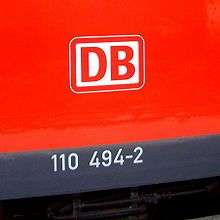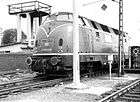DB locomotive classification
Originally, both Deutsche Bundesbahn and Deutsche Reichsbahn continued the classification system of the Deutsche Reichsbahn (DRG) – see also a short overview of the numbering system of the German railways. When UIC introduced a new classification system that could be processed by the computers of the late 1960s, DB did a major modification of their system, effective 1 January 1968. This system is still in use and now includes the engines of the former GDR railways as well. (See List of Deutsche Bahn AG locomotives and railbuses for a current list.)
Basics
Since January 1, 1968, all vehicles are denoted by a seven-digit vehicle number. It consists of a three-digit class number, a three-digit serial number and a check digit separated by a dash. The check digit is calculated by multiplying the first six digits by 1 and 2 alternately, the difference of the result to the next multitude of ten is the check digit. The check digit is used to perform a cross-check to ensure the correct number, for example in computer systems.
Series that contain more than 1,000 vehicles are assigned ascending numbers.
The first number denotes the type of the vehicle, replacing the DRG convention of using letters to differentiate between the vehicle types.
| Number | Letter(s) | Vehicle type |
|---|---|---|
| 0 | Steam locomotives | |
| 1 | E | Electric locomotives |
| 2 | V | Diesel locomotives |
| 3 | K | Small shunting locomotives |
| 4 | ET | Electric multiple units, not including battery-powered |
| 5 | ETA | Battery-powered railcars |
| 6 | VT | Diesel multiple units |
| 7 | Railbuses and work vehicles | |
| 8 | ES, EB | Cab cars and accompanying cars to electric railcars |
| 9 | VS, VB | Cab cars and accompanying cars to diesel railcars and railbuses |
The letters of the DRG schema are not officially used any more since the introduction of computer numbers, however they can often be found in informal writing and conversation. So if somebody is talking of an E110, he or she is likely to mean an E10 / 110, if a V216 is mentioned, it is likely that the author means the V160 / 216.
Tenders are not assigned a number of their own, as they are regarded a part of the vehicle they are coupled to. Cab cars and intermediate cars of multiple units receive the numbers 8 if they belong to an EMU, 9 if they belong to a DMU. If another powered car or engine is present in the multiple unit, its serial number usually is offset by 500, but it is still assigned into the original class.
For example, a two-car Class 628 DMU would look like:
- 628 210-7 (powered cab car)
- 928 210-4 (non-powered cab, hence 9 instead of 6)
A class 420 commuter EMU, for example, would look like this:
- 420 210-1 (powered cab car)
- 421 210-2 (powered intermediate car)
- 420 710-7 (powered cab car, +500)
Example 1: 110 494-2

| Meaning of 110 494-2 | |
|---|---|
| 110 | Class number → first number (1) meaning electric locomotive |
| 494 | Serial number |
| 2 | Check digit |
| How to calculate the check digit | |
| 1, 0, 9 | Record 1st, 3rd and 5th digit. |
| 2, 8, 8 | Record twice the value of each of the 2nd, 4th and 6th digit. |
| 1+0+9+2+8+8=28 | For the six results add all the different digits together. |
| 30 - 28 = 2 | Difference of the result to the next
multiple of ten is the check digit (or 0 if multiple of 10). |
| 2 | check digit |
Example 2: 044 557-7
| Meaning of 044 557-7 | |
|---|---|
| 044 | Class number
→ first number (0) meaning steam locomotive |
| 557 | Serial number |
| 7 | Check digit |
| How to calculate the check digit | |
| 0, 4, 5 | Record 1st, 3rd and 5th digit. |
| 8, 10, 14 | Record twice the value of each of the 2nd, 4th and 6th digit. |
| 0+4+5+8+1+0+1+4=23 | For the six results add all the different digits together. |
| 30 - 23 = 7 | Difference of the result to the next
multiple of ten is the check digit (or 0 if multiple of 10). |
| 7 | check digit |

Steam locomotives
See also: DRG locomotive classification for the origins of the system.
The number 0 was assigned to steam locomotives, as their end of duty was already foreseeable. The schematics are largely derivative of the DRG system of classification, therefore like in the older system the class numbers were grouped by locomotive types:
| Number | Vehicle types |
|---|---|
| 001–019 | Express train tender locomotives |
| 020–039 | Other Passenger train tender locomotives |
| 040–059 | Freight train tender locomotives |
| 060–079 | Passenger train tank locomotives |
| 080–096 | Freight train tank locomotives |
| 097 | Rack locomotives (in theory only - none were left by 1968) |
| 098 | Lokalbahn (branch line) engines |
| 099 | narrow gauge locomotives |
Steam locomotives that had been converted to oil fuelling received separate class numbers from their coal-fuelled counterparts, e. g. oil-fuelled units from the old class 44 were assigned to class 043 while coal-fuelled ones were assigned to class 044 under the new numbering plan. The DRB Class 50 (with originally more than 3,000 units, of which DB still had more than 1,000 by the end of 1967) gave rise to BR 050, 051, 052 and 053.
A noteworthy change from the old system was that four-digit engine numbers were no longer possible. Locomotives with such a number would either be put into an overflow class (e. g. 50 3097 became 053 097-2) or have their number abbreviated to three digits. The latter solution could lead to number conflicts in cases where the original (sub)class had comprised more than 1,000 units. These were dealt with by adjusting one of the numbers involved, e. g., 38 3711 became 038 711-8 while 38 1711 became 038 710-0. This also means that for some classes it is not possible to reconstruct the old number from the new one in a purely systematic way.
The last steam locomotives in the Deutsche Bundesbahn were decommissioned on 26 October 1977 at Rheine und Emden locomotive depot (Bahnbetriebswerk or Bw). These were the 043 903, 043 315 and 043 196 .
Electric engines
Electric engines were considered the most important method of traction, and hence were assigned the number 1. They usually were relabelled by replacing the letter "E" with the number "1". For example, the Einheits-Elektrolokomotiven were relabelled from E 40 into 140, E 10 into 110 and E 10.12 into 112.
Diesel engines

In the pre-1968 scheme, diesel engines were assigned the letter "V" (as in the German term Verbrennungsmotor for combustion engine). The old numbers were directly proportional with the engine power, so that two- and three-digit codes existed. Two-digit codes were transposed one by one (Examples: Class V60 became Class 260, Class V80 became Class 280). Three digit codes generally lost their last digit (V 160 became DB Class 216). Variants of the previously same class were also assigned individual subclasses, the V 160 family, consisting of V 160, V 160 long (V 160.3, V 168), V 162, V 164 and V 169 were assigned the numbers 210, 215, 216, 217, 218 and 219, for example.)
Small locomotives
Small shunting locomotives were assigned the number "3". The second number indicates the engine power (according to 1955 standards). The third number differentiates between brakes and transmission (chain drive or Cardan shafts). Small locomotives of the former Ka series were given the new class numbers 381 (pre-war models) and 382 (new models). The existing narrow gauge locomotives of the Wangerooge Island Railway became Class 329. In 1987 the DB Class 260/261 were also assigned to the small locomotives and labelled as Class 360/361.